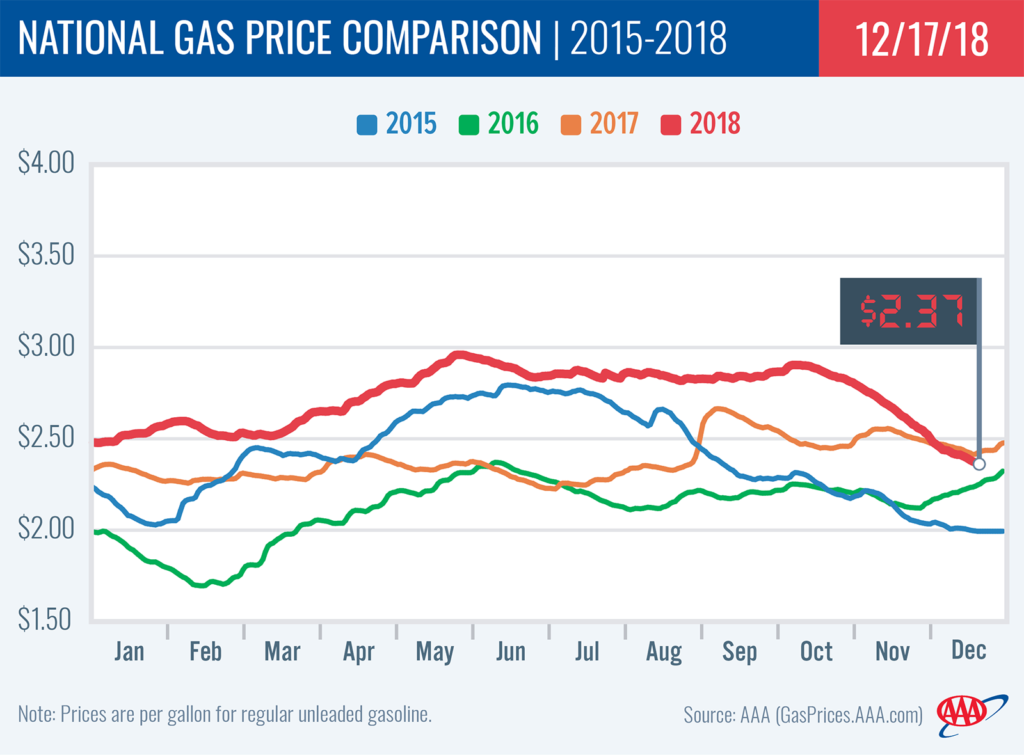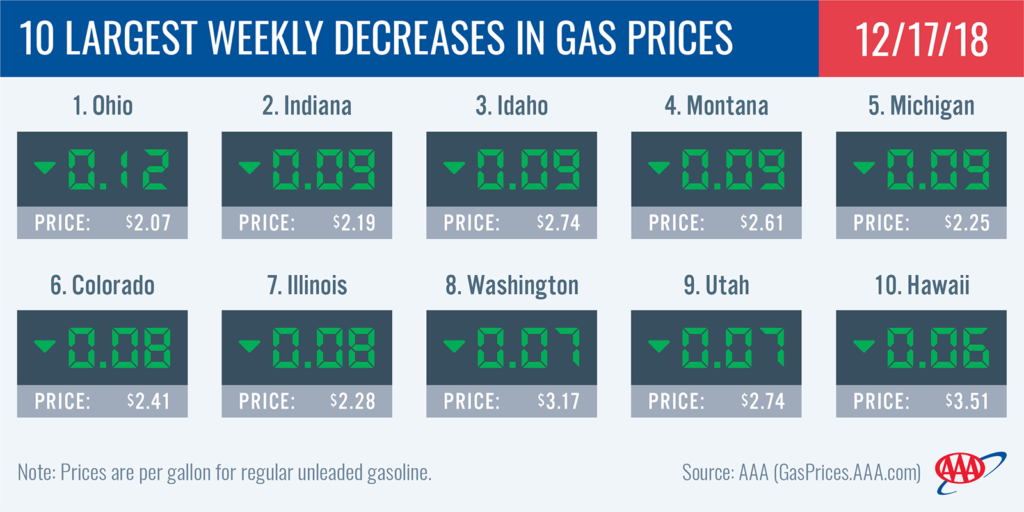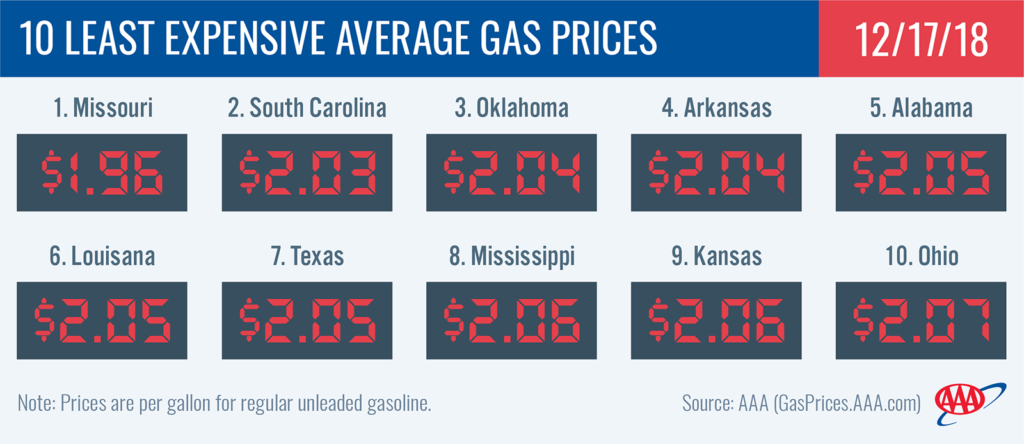At $2.37, the national gas price average continues to drive toward the cheapest pump prices seen during the month of December since 2016, which is welcome news for the millions of Americans expected to begin holiday travel later this week.
“AAA expects 102 million Americans to drive to their holiday destination this year, which is a four percent increase year-over-year,” said Jeanette Casselano, AAA spokesperson. “No doubt cheaper gas prices are fueling their decision to hit the road.”
On the week, states are seeing gas price averages that are as much as 12-cents cheaper. Florida (+1 cent) is the only state to see gas prices increase, while Missouri’s gas price average dropped to $1.96.
The national average is a nickel less than last week, 26-cents less than last month and six-cents less than a year ago. With gasoline production on the high side – 10 million b/d – amid low demand, motorists can expect gas prices to continue declining through year-end.
Quick Stats
- The nation’s top 10least expensive markets are: Missouri ($1.96), South Carolina ($2.03), Oklahoma ($2.04), Arkansas ($2.04), Alabama ($2.05), Louisiana ($2.05), Texas ($2.05), Mississippi ($2.06), Kansas ($2.06) and Ohio ($2.07).
- The nation’s top 10 largest weekly decreases are: Ohio (-12 cents), Indiana (-9 cents), Idaho (-9 cents), Montana (-9 cents), Michigan (-9 cents), Colorado (-8 cents), Illinois (-8 cents), Washington (-7 cents), Utah (-7 cents) and Hawaii (-6 cents).
Great Lakes and Central
At the start of the week, pump prices are cheaper on the week for all Great Lakes and Central states. This week’s declines wiped out any increases from the previous week in Ohio (-12 cents), Indiana (-9 cents) and Michigan (-9 cents). In fact, these states, in addition to Illinois (-8 cents) land on the top 10 list with the largest weekly changes in the country.
At $1.96, Missouri has the cheapest gas price average in the region and in the country. The last time the state saw prices this cheap was two years ago in December 2016. At that time, crude oil prices ranged from $50-52/bbl, which is similar to crude oil prices as of late.
Regional refinery utilization jumped from 94 to 98 percent and along with it added 350,000 bbl, according to the latest Energy Information Administration (EIA) reports. Total gasoline stocks in the region register at 49.8 million bbl – a healthy mark for this time of year and a 2.5 million bbl year-over-year surplus.
South and Southeast
Many South and Southeast states have gas price averages that are pennies away from falling below $2/gal: South Carolina ($2.03), Oklahoma ($2.04), Arkansas ($2.04), Alabama ($2.05), Louisiana ($2.05), Texas ($2.05) and Mississippi ($2.06). These states also rank among the top 10 cheapest averages in the country this week. Pump prices are at least a dime more expensive in Georgia ($2.18), Florida ($2.29) and New Mexico ($2.30). On the week, Florida (+1 cent) was the only state in the country and region to see prices increase.
Gasoline stocks built by 3 million bbl on the week, wiping out the previous week’s draw. The build brings the region’s total stock levels to 83.8 million bbl, which is a 5.4 million bbl year-over-year surplus. Since demand is low this time of year, it is not uncommon to see stocks build during December.
Mid-Atlantic and Northeast
State gas price averages are $2.70 or cheaper across the Mid-Atlantic and Northeast region. On the week, gas prices are up to six cents less: West Virginia (-6 cents), Tennessee (-5 cents) and Virginia (-5 cents) saw the largest changes.
Heading into the holidays, gas prices are as much as 15-cents cheaper year-over-year in the region.
EIA data shows that the region has seen gasoline stocks mostly decline since early October. On the week, stocks fell by 1.9 million bbl dropping total levels to 59 million bbl. The drop comes as refinery utilization in the region fell from 93 percent to 85 percent.
Rockies
On the week, four states from the Rockies region land on the top 10 list with the largest weekly change: Idaho (-9 cents), Montana (-9 cents), Colorado (-8 cents) and Utah (-7 cents). While not on the top 10 list, Wyoming’s state gas price average dropped a nickel on the week. Compared to the rest of the country, gas prices remain expensive in the region ranging from as cheap as $2.41 in Colorado to as expensive as $2.75 in Wyoming.
EIA data shows that gasoline stocks remain unchanged at 6.9 million bbl. This week’s forthcoming EIA report could show an increase in stocks as regional refinery utilization jumped from 86 to 92 percent.
West Coast
Pump prices in the West Coast region remain among the highest in the nation, with all of the region’s states landing on the nation’s top 10 most expensive list. Hawaii ($3.51) is the nation’s most expensive market, followed by California ($3.40), Washington ($3.17), Alaska ($3.09), Nevada ($3.03), Oregon ($3.01), and Arizona ($2.72). While expensive, they are getting cheaper with all state averages moving lower on the week: Washington (-7 cents), Hawaii (-6 cents), Oregon (-6 cents) and Nevada (-6 cents) saw the largest drops.
The EIA’s weekly petroleum status report, for the week ending on December 7, showed West Coast gasoline stocks increased by approximately 600,000 bbl to 28.3 million bbl. Stocks are approximately 2.4 million bbl lower than at this time last year, which could cause prices to spike if there is a supply challenge in the region this week.
Oil market dynamics
At the close of Friday’s formal trading session on the NYMEX, WTI decreased $1.38 to settle at $51.20. Oil prices mostly fell last week as market observers continue to worry that the global crude market is oversupplied. Although the Organization of the Petroleum Exporting Countries (OPEC) and other oil producers, including Russia, agreed last week to reduce output by 1.2 million barrels per day at the beginning of 2019, crude prices will likely remain low until the production reduction agreement is in place.
In related news, total domestic crude inventories are continuing to slide. Crude inventories around the country fell by 1.2 million bbl, according to new data released by EIA. Stocks now total 442 million bbl, which is approximately 1 million bbl lower than where they were at this time last year. With domestic inventories now falling and OPEC’s production reduction agreement set to take effect in early 2019, crude prices could increase early next year. If they do, motorists will likely see pump prices increase.
Motorists can find current gas prices along their route with the free AAA Mobile app for iPhone, iPad and Android. The app can also be used to map a route, find discounts, book a hotel and access AAA roadside assistance. Learn more at AAA.com/mobile.



